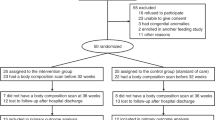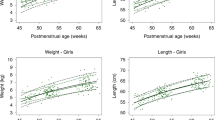Abstract
Objectives
South Asian body composition is characterized by higher body fat at any given BMI. While this does not occur during fetal growth, it is important to understand if inappropriate fat accretion then begins in the first 2 years in Indian infants.
Methods
The fat mass (FM) and fat-free mass (FFM) of healthy term newborns was evaluated at 12 days, 3.5 months, 1 year, and 2 years, by deuterium oxide (D2O) dilution. The effect of being born small versus appropriate for gestational age (SGA vs. AGA), and accelerated early growth pattern on FM and FFM accretion was also investigated.
Results
Newborns (262 total, 150 males) with mean birth weight of 2863 ± 418 g were enrolled. FM percentage (FM%) assessed by D2O in 144, 166, 81, and 115 infants at 12 days, 3.5 months, 1 year, and 2 years respectively, was11.6 ± 6.8, 21.1 ± 7.0, 17.9 ± 8.2 and 22.4 ± 9.5%. Boys had higher FFM at all ages, but FM% was similar in both sexes. Children born SGA had similar FM index (FMI) but a lower FFM index (FFMI) at 2 years compared with those born AGA. Infants with catch-up growth between 0 and 2 years had higher FMI at 2 years compared to those without. Infants in the present study had a lower FM% and FMI till 1 year of age in comparison to previous studies from other countries, but had an increase in adiposity between 1 and 2 years, whereas in previous studies FM% remained stable or declined between 1 and 2 years of age.
Conclusion
There was an upward inflection in the curve of FM% and FMI between 1 and 2 years of age in the present study, which may represent an early adiposity rebound. Further longitudinal body composition data for Indian infants as well as those of other ethnicities but with low birth weight will clarify whether early accelerated growth pattern contributes to greater accrual of fat rather than lean mass during childhood.
This is a preview of subscription content, access via your institution
Access options
Subscribe to this journal
Receive 12 print issues and online access
$259.00 per year
only $21.58 per issue
Buy this article
- Purchase on Springer Link
- Instant access to full article PDF
Prices may be subject to local taxes which are calculated during checkout


Similar content being viewed by others
References
Lear SA, Kohli S, Bondy GP, Tchernof A, Sniderman AD. Ethnic variation in fat and lean body mass and the association with insulin resistance. J Clin Endocrinol Metab. 2009;94:4696–702.
Misra A, Chowbey P, Makkar BM, Vikram NK, Wasir JS, Chadha D, et al. Consensus Group. Consensus statement for diagnosis of obesity, abdominal obesity and the metabolic syndrome for Asian Indians and recommendations for physical activity, medical and surgical management. J Assoc Physicians India. 2009;57:163–70.
Ramuth H, Hunma S, Ramessur V, Ramuth M, Monnard C, Montani JP, et al. Body composition-derived BMI cut-offs for overweight and obesity in ethnic Indian and Creole urban children of Mauritius. Br J Nutr. 2020;124:481–92.
Mehta S, Mahajan D, Steinbeck KS, Bermingham MA. Relationship between measures of fatness, lipids and ethnicity in a cohort of adolescent boys. Ann Nutr Metab. 2002;46:192–9.
Wibaek R, Vistisen D, Girma T, Admassu B, Abera M, Abdissa A, et al. Body mass index trajectories in early childhood in relation to cardiometabolic risk profile and body composition at 5 years of age. Am J Clin Nutr. 2019;110:1175–85.
Wells JC. Body composition in infants: Evidence for developmental programming and techniques for measurement. Rev Endocr Metab Disord. 2012;13:93–101.
Yajnik CS, Fall CH, Coyaji KJ, Hirve SS, Rao S, Barker DJ, et al. Neonatal anthropometry: The thin-fat Indian baby. The Pune Maternal Nutrition Study. Int J Obes Relat Metab Disord. 2003;27:173–80.
Krishnaveni GV, Hill JC, Veena SR, Leary SD, Saperia J, Chachyamma KJ, et al. Truncal adiposity is present at birth and in early childhood in South Indian children. Indian Pediatr. 2005;42:527–38.
Jain V, Kurpad AV, Kumar B, Devi S, Sreenivas V, Paul VK. Body composition of term healthy Indian newborns. Eur J Clin Nutr. 2016;70:488–93.
Kuriyan R, Naqvi S, Bhat KG, Ghosh S, Rao S, Preston T, et al. The thin but fat phenotype is uncommon at birth in Indian babies. J Nutr. 2020;150:826–32.
Andersen GS, Girma T, Wells JC, Kæstel P, Leventi M, Hother AL, et al. Body composition from birth to 6 mo of age in Ethiopian infants: Reference data obtained by air-displacement plethysmography. Am J Clin Nutr. 2013;98:885–94.
Larsson A, Ottosson P, Törnqvist C, Olhager E. Body composition and growth in full-term small for gestational age and large for gestational age Swedish infants assessed with air displacement plethysmography at birth and at 3-4 months of age. PLoS One. 2019;14:e0207978.
Villar J, Cheikh Ismail L, Victora CG, Ohuma EO, Bertino E, Altman DG, et al. International Fetal and Newborn Growth Consortium for the 21st Century (INTERGROWTH-21st). International standards for newborn weight, length, and head circumference by gestational age and sex: the Newborn Cross-Sectional Study of the INTERGROWTH-21st Project. Lancet 2014;384:857–68.
Ong KK, Ahmed ML, Emmett PM, Preece MA, Dunger DB. Association between postnatal catch-up growth and obesity in childhood: Prospective cohort study. BMJ 2000;320:967–71.
Davies PS, Wells JC. Calculation of total body water in infancy. Eur J Clin Nutr. 1994;48:490–5.
Demerath EW, Fields DA. Body composition assessment in the infant. Am J Hum Biol. 2014;26:291–304.
Weststrate JA, Deurenberg P. Body composition in children: Proposal for a method for calculating body fat percentage from total body density or skinfold-thickness measurements. Am J Clin Nutr. 1989;50:1104–15.
Jain V, Kumar B, Khatak S. Catch-up and catch-down growth in term healthy Indian infants from birth to two years: A prospective cohort study. Indian Pediatr. 2021;58:325–31.
Fomon SJ, Haschke F, Ziegler EE, Nelson SE. Body composition of reference children from birth to age 10 years. Am J Clin Nutr. 1982;35:1169–75.
Butte NF, Hopkinson JM, Wong WW, Smith EO, Ellis KJ. Body composition during the first 2 years of life: An updated reference. Pediatr Res. 2000;47:578–85.
Eriksson B, Löf M, Forsum E. Body composition in full-term healthy infants measured with air displacement plethysmography at 1 and 12 weeks of age. Acta Paediatr. 2010;99:563–8.
Henriksson H, Eriksson B, Forsum E, Flinke E, Henriksson P, Löf M. Longitudinal assessment of body composition in healthy Swedish children from 1 week until 4 years of age. Eur J Clin Nutr. 2017;71:1345–52.
de Fluiter KS, van Beijsterveldt IALP, Goedegebuure WJ, Breij LM, Spaans AMJ, Acton D, et al. Longitudinal body composition assessment in healthy term-born infants until 2 years of age using ADP and DXA with vacuum cushion. Eur J Clin Nutr. 2020;74:642–50.
Carberry AE, Colditz PB, Lingwood BE. Body composition from birth to 4.5 months in infants born to non-obese women. Pediatr Res. 2010;68:84–8.
Fields DA, Gilchrist JM, Catalano PM, Giannì ML, Roggero PM, Mosca F. Longitudinal body composition data in exclusively breast-fed infants: A multicenter study. Obesity. 2011;19:1887–91.
Ibáñez L, Ong K, Dunger DB, de Zegher F. Early development of adiposity and insulin resistance after catch-up weight gain in small-for-gestational-age children. J Clin Endocrinol Metab. 2006;91:2153–8.
Ibáñez L, Suárez L, Lopez-Bermejo A, Díaz M, Valls C, de Zegher F. Early development of visceral fat excess after spontaneous catch-up growth in children with low birth weight. J Clin Endocrinol Metab. 2008;93:925–8.
Wells JCK, Davies PSW, Fewtrell MS, Cole TJ. Body composition reference charts for UK infants and children aged 6 weeks to 5 years based on measurement of total body water by isotope dilution. Eur J Clin Nutr. 2020;74:141–8.
Rolland-Cachera MF, Deheeger M, Bellisle F, Sempe M, Guilloud-Bataille M, Patois E. Adiposity rebound in children: A simple indicator for predicting obesity. Am J Clin Nutr. 1984;39:129–35.
Plachta-Danielzik S, Bosy-Westphal A, Kehden B, Gehrke MI, Kromeyer-Hauschild K, Grillenberger M, et al. Adiposity rebound is misclassified by BMI rebound. Eur J Clin Nutr. 2013;67:984–9.
Schoeller D. Hydrometry. In: Heymsfield S, Lohman T, Wang Z (eds). Human Body Composition: Human Kinetics, 2nd ed. Champaign, IL, USA, 2005, pp 35–50.
Bandara T, Hettiarachchi M, Liyanage C, Amarasena S, Wong WW. Body composition among Sri Lankan infants by 18O dilution method and the validity of anthropometric equations to predict body fat against 18O dilution. BMC Pediatr. 2015;15:52.
Cauble JS, Dewi M, Hull HR. Validity of anthropometric equations to estimate infant fat mass at birth and in early infancy [published correction appears in BMC Pediatr 2020;20:92]. BMC Pediatr. 2017;17:88.
Barbour LA, Hernandez TL, Reynolds RM, Reece MS, Chartier-Logan C, Anderson MK, et al. Striking differences in estimates of infant adiposity by new and old DXA software, PEAPOD and skin-folds at 2 weeks and 1 year of life. Pediatr Obes. 2016;11:264–71.
Acknowledgements
Sapna Khatak, Anuj Kumar, and Naveen Kumar for technical help with the acquisition of data.
Funding
Department of Biotechnology, Government of India (Grant No. BT/PR3884/ Med97/03/2011 to VJ).
Author information
Authors and Affiliations
Contributions
VJ conceived and supervised the study and drafted the manuscript, BK helped with recruitment and follow-up of subjects, data collection, and analysis, SD performed the D2O assays and helped with their interpretation, AJ helped with data analysis and review of literature, MJ supervised the DXA measurements, AK helped in planning the study, supervised the D2O assays, and critically revised the manuscript. All authors have given their inputs for and approved the final manuscript.
Corresponding authors
Ethics declarations
Ethical approval
AIIMS Ethics Committee; No. IEC/NP-127/2012 and RP-21/2012, dated April 27, 2012.
Competing interests
The authors declare no competing interests.
Additional information
Publisher’s note Springer Nature remains neutral with regard to jurisdictional claims in published maps and institutional affiliations.
Supplementary information
Rights and permissions
About this article
Cite this article
Jain, V., Kumar, B., Devi, S. et al. Body composition from birth to 2 years in term healthy Indian infants measured by deuterium dilution: Effect of being born small for gestational age and early catch-up growth. Eur J Clin Nutr 76, 1165–1171 (2022). https://doi.org/10.1038/s41430-022-01071-z
Received:
Revised:
Accepted:
Published:
Issue Date:
DOI: https://doi.org/10.1038/s41430-022-01071-z
This article is cited by
-
Birth outcomes and early growth patterns associated with age at adiposity rebound: the Ma’anshan birth cohort (MABC) study
BMC Public Health (2023)
-
Bone Mineral Content and Density in Healthy Term Indian Infants at the Age of 1 and 2 Years Assessed by Dual-Energy X-Ray Absorptiometry
Indian Journal of Pediatrics (2023)
-
Comparison of Anthropometry and Body Composition Using Air Displacement Plethysmography in Term Small for Gestational Age and Appropriate for Gestational Age Neonates
Indian Pediatrics (2023)



